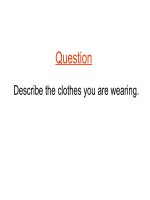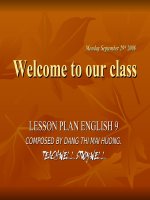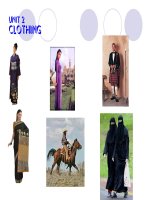Unit 2 Clothing week 5
Bạn đang xem bản rút gọn của tài liệu. Xem và tải ngay bản đầy đủ của tài liệu tại đây (104.87 KB, 3 trang )
<span class='text_page_counter'>(1)</span>Period: 9 UNIT 2: CLOTHING LISTEN I. Objectives 1. Knowledge, Skills, Attitude: - Ss improve their listening skill: listen and choose the correct pictures about what is Mary doing. + Vocabulary: Related to clothing + Grammar: The present progressive tense Ss will be able to write an exposition. - Listening, les speaking, reading and writing - Educate Ss about how to choose suitable clothes. 2. capacity can be formed and developed for students - Self-learning capability II. Preparation 1. Teacher: lesson plane, book, color chalks, pictures, cassette and tape 2. Students: books, notebooks, pen, ruler … III. Students’ activities 1. Warm-up Teacher’s and students’ activities Content - T asks, Ss answer the question. - What kinds of clothes do little girls often wear? 2. Knowledge formation activities Teacher’s and students’ activities - T explains the requirement; Ss listen to teacher’s explanation.. Content 4. Listen: - Ss listen and choose the correct pictures about what is Mary doing. * Pre-listening You will hear a public announcement about a lost little girl called Mary. Listen and check (v) the letter of the correct picture to show what Mary is wearing. Questions : a. What do you call these clothes in English? b. What kinds of clothes is this? c. Are these shoes or sandals? * While-listening Answer keys : a. B: She’s wearing blue shorts. b. A: She’s wearing a long-sleeved white blouse. c. She’s wearing brown shoes.. - T hangs the pictures and asks Ss some questions. - Ss look at the pictures and try to answer teacher’s questions. - Ss guess what Mary is wearing. - T plays the tape three times or more. - Ss listen to the tape and choose the correct pictures. - Ss compare the answers in pairs. - T calls some Ss to give the answers. - T plays the tape again in order to check and correct. - Ss copy down the correct answers. - T prepares some pictures of boys and girls. Ss look at the pictures. One S describes one of these people, others recognizes who she/he is. * Post-listening Game: “Who is he/she?” 3. Consolidation T asks, Ss answer the questions: a. How old is Mary? b.What kinds of clothes and shoes is she wearing? c.If you see Mary, what will you do? IV. Experience:.
<span class='text_page_counter'>(2)</span> ……………………………………………………………………………………………………………………………………………………………………… ……………………………………………………………………………………………………………………………………………………………………… ………………………………………………………………………………………………………………………………………………………………………. Period: 10 UNIT 2: CLOTHING READ I. Objectives 1. Knowledge, Skills, Attitude: - Ss improve their reading skill: read and understand the improvement of jeans. + Vocabulary: Related to clothing + Grammar: The past simple tense - listening, les speaking, reading and writing - educate Ss about how to choose suitable clothes. 2. capacity can be formed and developed for students - Self-learning capability - Communicative competence - Cooperation capacity II. Preparation 1. Teacher: lesson plane, book, color chalks, pictures, cassette and tape 2. Students: books, notebooks, pen, ruler … III. Students’ activities 1. Warm-up: Questions Teacher’s and students’ activities Content 1. How do we call this in English? - T asks, Ss answer the questions. 2. Who loves wearing jeans? Why? 2. Knowledge formation activities Teacher’s and students’ activities Content - T hangs the picture and asks, Ss answer the 5. Read questions.(if Ss can’t answer, they can answer *Pre-reading the questions after reading the text) 1. Are they wearing jeans? 2. What do you want to know about jeans? (What jean cloth was made from, when it appeared for the first time and where.) - T reads the smart pen once. *While-reading New words : - Ss listen to teacher. - T helps Ss practice reading new words as - sailor (n) - style (n) well as understand their meanings. - T calls some Ss to read new words in order - embroider (adj) - label (n) to check and correct their pronunciation. - sale (n) - go up (v) - out of fashion (adj) - wear out (v) - economic (adj) - T explains the requirement of exercise a. a. Fill in the missing dates and words. - Ss read the text in silence and fill in the Answer keys : missing dates and words. 1. 18th century … Jean cloth… - Ss compare the answers in pairs. 2. 1960s … students… - T calls some Ss to give the answers. 3. 1970s … cheaper ….
<span class='text_page_counter'>(3)</span> - T checks and corrects the answers if necessary. - Ss copy down the correct answers. - T explains the requirement of exercise b. -Ss work in pairs: ask and answer the questions. - T calls some pairs to ask and answer before the class. - T checks and corrects students’ mistakes if necessary. - Ss copy down the correct answers.. - T asks, Ss answer the questions.. 4. 1980s … fashion … 5. 1990s … sale … b. Answer. Then write the answers in your exercise books. Answer keys : 1. The word jeans comes from a kind of material that was made in Europe. 2. The 1960s’ fashions were embroidered jeans, painted jeans and so on. 3. Because jeans became cheaper. 4. Jeans at last became high fashion clothing in the 1980s. 5. The sale of jeans stopped growing because the world-wide economic situation got worse in the 1990s. *Post-reading Questions : 1. Do you like wearing jeans? Why (not)? 2. What type of jeans do you love wearing? 3. Do you think jeans are in fashion now?. 3. Consolidation T asks, Ss answer the questions: a. Tell some thing you know about jeans. b. Are students in our school allowed to wear jeans to school? IV. Experience: ……………………………………………………………………………………………………………………………………………………………………… ……………………………………………………………………………………………………………………………………………………………………… ………………………………………………………………………………………………………………………………………………………………………. Signature of the Leader Week 5 ..................................................................................................
<span class='text_page_counter'>(4)</span>









